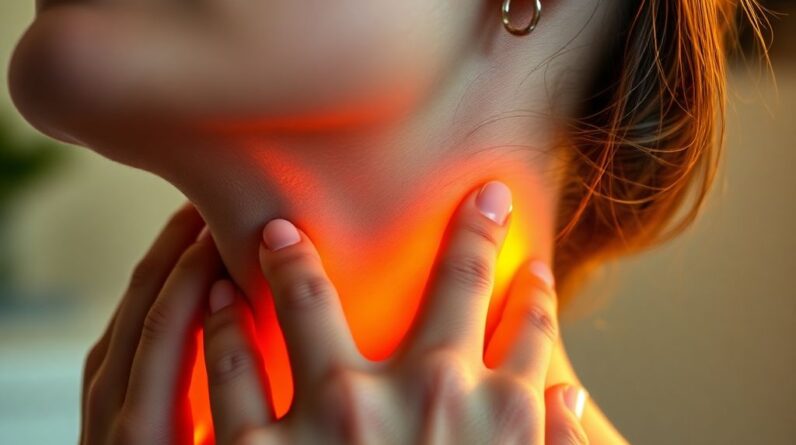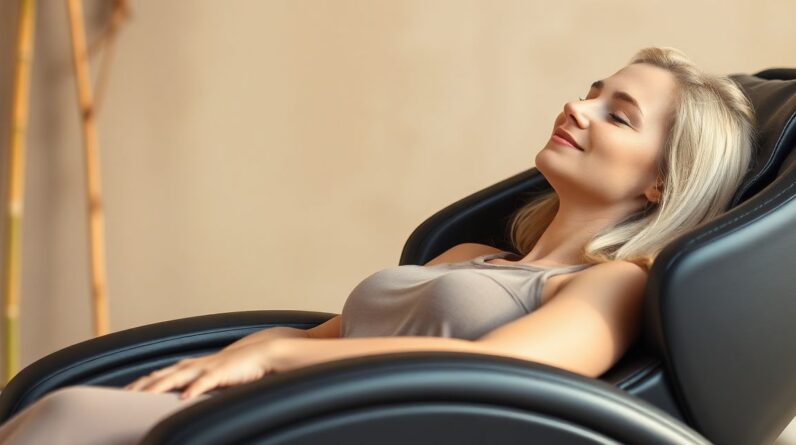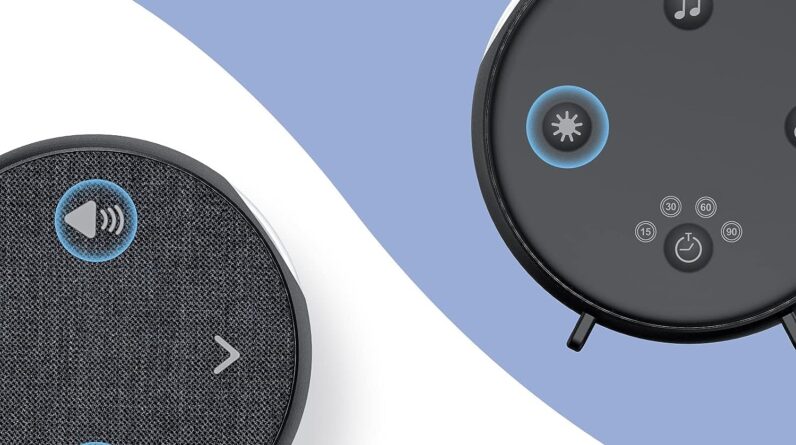
I used to think neck and shoulder pain was an unavoidable part of modern life. Hunched over my laptop for hours, I’d end each day with a stiff neck and aching shoulders.
It wasn’t until I reached a breaking point – unable to turn my head without wincing – that I realized I needed to take action.
That’s when I discovered the transformative power of self-massage for neck and shoulder pain.
At first, I was skeptical. How could my own hands provide the relief that even professional massages seemed to fall short of delivering?
Table of Contents
Understanding the Anatomy of Pain
Before we dive into specific techniques, it’s crucial to understand the anatomy of neck and shoulder pain. The neck and shoulder region is a complex network of muscles, tendons, and ligaments, all working together to support our head and allow a wide range of motion.
Key players in this area include:
- The trapezius muscle: This large, diamond-shaped muscle spans from the base of your skull to your mid-back and across your shoulders.
It’s responsible for moving, rotating, and stabilizing the shoulder blades.
- The levator scapulae: Running from the upper neck to the shoulder blade, this muscle helps elevate the shoulder blade and rotate the neck.
- The sternocleidomastoid: These are the rope-like muscles on either side of your neck.
They help rotate your head and flex your neck.
- The scalene muscles: Located on the side of the neck, these muscles assist with breathing and neck rotation.
When these muscles become tense or strained, often because of poor posture, stress, or repetitive movements, they can cause pain and discomfort that radiates throughout the neck and shoulder area.
The Science of Self-Massage
Self-massage works on many levels to reduce pain and promote healing:
- Increased blood flow: Massage stimulates circulation, bringing oxygen and nutrients to tired muscles while flushing out toxins.
This improved blood flow can speed up recovery and reduce inflammation.
- Release of endorphins: The physical manipulation of muscles triggers the release of endorphins, your body’s natural pain-killers.
These feel-good chemicals help reduce pain and promote a sense of well-being.
- Fascial release: Massage can help loosen the fascia, the connective tissue surrounding muscles.
When fascia becomes tight or restricted, it can cause pain and limit mobility.
By releasing fascial adhesions, self-massage can improve flexibility and reduce pain.
- Trigger point therapy: By applying pressure to specific points, you can release knots and reduce referred pain in other areas.
Trigger points are hyperirritable spots in the muscle that can cause pain in seemingly unrelated parts of the body.
- Stress reduction: The act of self-massage itself can be calming and meditative, helping to reduce overall stress levels.
Since stress is a common contributor to muscle tension, this benefit can create a positive feedback loop for pain relief.
Essential Self-Massage Techniques
Now, let’s explore some effective self-massage techniques for neck and shoulder pain:
1. The Neck Squeeze
Start by placing your hands on either side of your neck, fingers pointing towards the back of your head. Gently squeeze the muscles, working your way down from the base of your skull to your shoulders.
Apply firm but comfortable pressure, and breathe deeply as you go.
This technique targets the sternocleidomastoid and scalene muscles, which often hold tension from prolonged periods of looking down at screens.
As you perform this massage, pay attention to any areas that feel particularly tight or tender. These spots may benefit from a bit more attention, but remember to keep the pressure comfortable.
You can vary the technique by using your fingertips to make small circular motions as you move down the neck.
2. Shoulder Blade Release
Reach your right hand over your left shoulder, placing your fingertips on your left shoulder blade. Press and make small circular motions, exploring the area for any tight spots.
This technique targets the rhomboids and the middle trapezius, muscles that can become strained from poor posture or prolonged desk work.
As you massage, you might feel some crunchy or gritty sensations under your fingers. This is normal and indicates areas of tension or adhesions in the muscle.
Spend extra time on these spots, using slow, deliberate movements to help release the tension.
Remember to breathe deeply and relax your shoulders as you work.
Repeat on the other side, using your left hand to massage your right shoulder blade. You can also experiment with different hand positions to reach different areas of the shoulder blade.
3. Scalene Stretch and Massage
Tilt your head slightly to one side, then use your fingertips to gently massage the side of your neck, focusing on the area between your collarbone and jawline. Be gentle here, as this area contains important blood vessels and nerves.
The scalene muscles play a crucial role in breathing and neck movement, and tension here can contribute to a variety of symptoms, including headaches and arm pain.
As you massage, you can experiment with different angles of head tilt to target different fibers of the scalene muscles. You might feel some tender spots – these are often trigger points that can refer pain to other areas.
Apply gentle, sustained pressure to these points for 30-60 seconds, or until you feel the tension start to release.
4. Trapezius Kneading
Use your right hand to knead the left side of your upper back and shoulder, focusing on the trapezius muscle. Use your knuckles or fingertips to apply pressure in circular motions.
The trapezius is a large muscle that’s prone to developing knots and tension, especially in those who carry stress in their shoulders or spend a lot of time at a computer.
Start at the base of your neck and work your way out towards your shoulder, then down towards your shoulder blade. Vary the pressure and speed of your movements based on what feels good to you.
You might find some areas that are particularly tight or tender – spend extra time on these spots, using slow, deliberate pressure to help release the tension.
Switch sides and repeat, using your left hand to massage the right trapezius. You can also use both hands to massage both sides simultaneously, which can be particularly effective for releasing overall tension in the upper back and shoulders.
5. Tennis Ball Technique
Place a tennis ball between your back and a wall. Lean against it, positioning the ball on any tight spots in your upper back or shoulders.
Slowly move up and down or side to side to massage the area.
This technique allows you to apply deeper pressure than you might be able to with your hands alone, making it particularly effective for releasing stubborn knots in the upper back and shoulders.
Start by placing the ball just below your shoulder blade and lean into it with as much pressure as is comfortable. Take deep breaths and try to relax into the pressure.
As you breathe out, you might feel the muscle start to release and soften.
Slowly move your body to roll the ball around the area, pausing on any spots that feel particularly tight or tender.
You can also use this technique lying on the floor, which allows you to control the pressure more easily. Place the ball under your upper back and use your body weight to apply pressure.
Roll slowly in different directions, pausing on tight spots as needed.
Overcoming Common Challenges
While self-massage can be incredibly effective, it’s not without it’s challenges. Here are some common issues and how to address them:
Reaching difficult areas
One of the biggest challenges in self-massage is reaching all the areas that need attention. The upper back, in particular, can be tricky to access.
To overcome this, use tools like massage balls, foam rollers, or even household items like a rolling pin or a sock filled with tennis balls.
These tools can help you apply pressure to hard-to-reach spots.
For the neck area, you can use a tool called a cervical traction device, which cradles the neck and allows for gentle stretching and massage. Always start with gentle pressure when using any tool, and avoid applying direct pressure to the spine.
Applying the right pressure
Finding the right amount of pressure can be tricky. Too little, and you might not get the benefits – too much, and you could cause discomfort or even injury.
Start gently and gradually increase pressure.
If it hurts, ease off. The goal is to feel a “good hurt” – a sensation of pressure or slight discomfort that feels therapeutic, not painful.
Listen to your body and adjust accordingly. Remember that different areas may need different levels of pressure.
The neck, for example, generally needs a lighter touch than the shoulders or upper back.
Consistency
Like any self-care practice, consistency is key for seeing results with self-massage. Set reminders or incorporate self-massage into your daily routine, such as while watching TV or before bed. Even a few minutes each day can make a significant difference over time.
Consider creating a self-massage ritual. For example, you might do a quick neck and shoulder massage every morning after your shower, or spend 10 minutes with a foam roller before bed each night.
The more you can make it a habit, the more likely you are to stick with it and reap the benefits.
Time constraints
In our busy lives, finding time for self-care can be challenging. Remember that even a few minutes of targeted self-massage can make a difference.
Focus on quality over quantity.
A 5-minute session where you’re fully present and attentive to your body can be more useful than a longer session where you’re distracted or rushed.
Look for opportunities to incorporate brief massage moments into your day. For example, you might do some neck rolls and shoulder squeezes while waiting for your coffee to brew, or use a massage ball while sitting at your desk between tasks. These small acts of self-care can significantly reduce tension and promote a sense of well-being throughout your day. Additionally, consider pairing your brief massage moments with aromatherapy for relaxation and wellness, using essential oils like lavender or eucalyptus to enhance your experience. By integrating these techniques into your daily routine, you can cultivate a more mindful approach to relaxation, ultimately boosting both your mental and physical health.
Adapting Techniques for Different Scenarios
Self-massage can be adapted to various situations:
At the office
When you’re at work, you might not have the privacy or time for a full self-massage session. However, you can still incorporate discrete techniques to relieve tension throughout the day.
Try shoulder shrugs, neck rolls, or gentle scalp massages.
These can be done subtly at your desk without drawing attention.
Another great office technique is the “wall angel.” Stand with your back against a wall, then raise your arms to shoulder height, bent at the elbows. Slowly slide your arms up and down the wall, as if making a snow angel.
This helps stretch the chest and strengthen the upper back muscles, counteracting the effects of prolonged sitting.
During travel
Long flights or car rides can wreak havoc on your neck and shoulders. Pack a small massage ball for on-the-go relief.
You can use it against your seat back to work out knots, or hold it in your hand to massage your neck and shoulders.
When you have a layover or rest stop, take a few minutes to do some standing stretches. Shoulder rolls, neck rotations, and gentle backbends can help reduce tension from sitting for long periods.
For acute pain
If you’re dealing with acute pain – perhaps from sleeping awkwardly or a sudden strain – focus on gentle, soothing strokes as opposed to deep pressure. Light, rhythmic touches can help increase blood flow and promote relaxation without aggravating the injury.
You might also try contrast therapy: alternate between applying a cold pack and a warm compress to the affected area. This can help reduce inflammation and promote healing.
Always wrap ice packs in a towel to protect your skin, and limit application to 15-20 minutes at a time.
For chronic tension
For ongoing issues with neck and shoulder tension, incorporate longer, more frequent sessions into your routine. You might dedicate 15-20 minutes each evening to a more comprehensive self-massage routine, focusing on all the major muscle groups in your neck and shoulders.
Consider combining self-massage with other relaxation techniques, such as deep breathing exercises or progressive muscle relaxation. This holistic approach can help address both the physical and mental aspects of chronic tension.
Building on the Basics
As you become more comfortable with basic self-massage techniques, you can explore more advanced methods:
Myofascial release using foam rollers or massage guns
Foam rollers and massage guns can provide deeper tissue work than hands alone. Foam rollers are excellent for the upper back and shoulders.
Lie on the roller and slowly roll back and forth, pausing on tight spots.
For the neck, use a smaller roller or a massage ball for more precise pressure.
Massage guns offer intense, targeted pressure and can be particularly effective for stubborn knots. However, use caution around the neck area and start with the lowest intensity setting.
Incorporating essential oils for aromatherapy benefits
Adding essential oils to your self-massage routine can enhance relaxation and pain relief. Lavender, peppermint, and eucalyptus are popular choices for muscle tension.
Mix a few drops with a carrier oil like coconut or jojoba oil before applying to your skin.
Remember to do a patch test first to confirm you don’t have any adverse reactions, and never apply essential oils directly to your skin without diluting them first.
Combining self-massage with stretching or yoga
Integrating stretches or yoga poses into your self-massage routine can enhance flexibility and overall relaxation. For example, you might do some gentle neck stretches or shoulder rolls before starting your massage to warm up the muscles.
The “thread the needle” pose from yoga is excellent for releasing tension in the upper back and shoulders. Start on all fours, then slide one arm under your body, twisting to the side.
Hold for a few breaths, then switch sides.
Exploring pressure point therapy based on traditional Chinese medicine
Traditional Chinese medicine identifies specific pressure points that, when stimulated, can relieve pain and promote healing. For neck and shoulder pain, key points include:
- GB21: Located at the highest point of the shoulder
- LI4: Found in the webbing between your thumb and index finger
- SI3: On the outside edge of the hand, just below the pinky finger
Apply gentle, sustained pressure to these points for 30-60 seconds at a time. Remember, pressure point therapy should be gentle – if you feel pain, reduce the pressure.
Practical Exercises to Try
Morning Neck Wake-Up
Spend 2-3 minutes each morning gently massaging your neck and shoulders to start your day pain-free. Begin with some gentle neck rolls to warm up the muscles.
Then, use your fingertips to massage the base of your skull, working your way down the sides of your neck to your shoulders.
Pay special attention to any areas that feel particularly tight or tender. Finish with some shoulder shrugs and rolls to promote blood flow and flexibility.
This quick routine can help set a positive tone for the day and prevent tension from building up.
Desk Break Rejuvenation
Set an hourly reminder to do a quick 30-second shoulder and neck massage at your desk. Start by sitting up straight and taking a deep breath.
Roll your shoulders backwards three times, then forwards three times.
Gently tilt your head to one side, using your hand to apply light pressure and stretch the opposite side of your neck. Hold for a few seconds, then switch sides.
Finally, use your fingertips to massage the base of your skull and the tops of your shoulders. This brief routine can help prevent the buildup of tension from prolonged sitting and computer use.
Pre-Sleep Relaxation
Incorporate a 5-minute self-massage routine into your bedtime ritual to release the day’s tension. Start by lying on your back with a small pillow under your knees to relax your lower back.
Use your fingertips to gently massage your temples in small circular motions.
Move to the base of your skull, applying gentle pressure with your fingertips.
Next, use your palms to massage your neck and shoulders, using slow, deliberate strokes. Finish by gently kneading any areas that feel particularly tense.
This routine can help promote relaxation and prepare your body for restful sleep.
Breath-Focused Massage
Practice deep breathing while massaging, inhaling as you apply pressure and exhaling as you release. This technique combines the benefits of massage with those of deep breathing, enhancing relaxation and stress relief.
Start by focusing on your breath, taking slow, deep inhales and exhales. As you inhale, apply pressure to a tense area in your neck or shoulders.
As you exhale, release the pressure and feel the tension melting away.
Continue this pattern, moving to different areas as needed.
This mindful approach to self-massage can help you tune into your body’s needs and enhance the relaxation benefits of the massage.
People Also Asked
How often should I do self-massage for neck and shoulder pain?
For best results, aim to incorporate some form of self-massage into your daily routine. Even 5-10 minutes a day can make a significant difference.
If you’re dealing with acute pain or a flare-up, you might benefit from more frequent, shorter sessions throughout the day.
Can self-massage make my neck pain worse?
While self-massage is generally safe, it’s possible to aggravate an existing condition if you use too much pressure or massage an inflamed area. Always start gently and listen to your body.
If you experience increased pain or discomfort, stop the massage and consult a healthcare professional.
What’s the best time of day to do self-massage for neck and shoulder pain?
The best time is whenever you can consistently fit it into your schedule. Many people find morning massages help set a pain-free tone for the day, while evening massages can promote relaxation before bed. Experiment to find what works best for you.
Are there any tools I can use for self-massage?
Yes, there are many tools available. Foam rollers, massage balls, and handheld massagers can all be effective.
Even household items like tennis balls or a rolling pin can work in a pinch.
Choose tools that allow you to comfortably reach your problem areas.
Can self-massage help with tension headaches?
Many tension headaches originate from neck and shoulder tension. Self-massage techniques that target these areas, particularly the base of the skull and upper neck, can often help reduce tension headaches.
Is it normal to feel sore after self-massage?
Mild soreness after a deep massage is normal and usually subsides within a day or two. This is similar to the soreness you might feel after a workout.
However, if you experience sharp pain or prolonged discomfort, you may have massaged too aggressively.
How long does it take to see results from regular self-massage?
While you might feel immediate relief after a session, lasting improvements typically need consistent practice over time. Many people report noticeable improvements in pain and flexibility within 2-4 weeks of regular self-massage.
Can self-massage replace professional massage therapy?
While self-massage can be a valuable tool for managing neck and shoulder pain, it may not completely replace professional massage therapy, especially for chronic or complex issues. Professional therapists can often reach areas you can’t and may use techniques you’re not able to perform on yourself.
Are there any conditions where self-massage for neck and shoulder pain is not recommended?
Self-massage should be avoided if you have open wounds, skin infections, or recent injuries in the area. It’s also not recommended if you have blood clots, severe osteoporosis, or certain types of cancer.
Always talk to a healthcare provider if you’re unsure.
How can I tell if I’m doing self-massage correctly?
Proper self-massage should feel good – you might experience a “good hurt,” but it shouldn’t be painful. You should feel a gradual release of tension and increased warmth in the area.
If you’re unsure, consider booking a session with a professional massage therapist who can show techniques and provide personalized advice.
Key Takeaways
- Self-massage increases blood flow and releases endorphins, promoting healing and pain relief.
- Focus on major muscle groups like the trapezius, levator scapulae, and scalenes.
- Use a variety of techniques, from gentle kneading to targeted pressure point therapy.
- Consistency is key – even short, regular sessions can make a significant difference.
- Listen to your body and adjust techniques as needed for your specific pain patterns.





